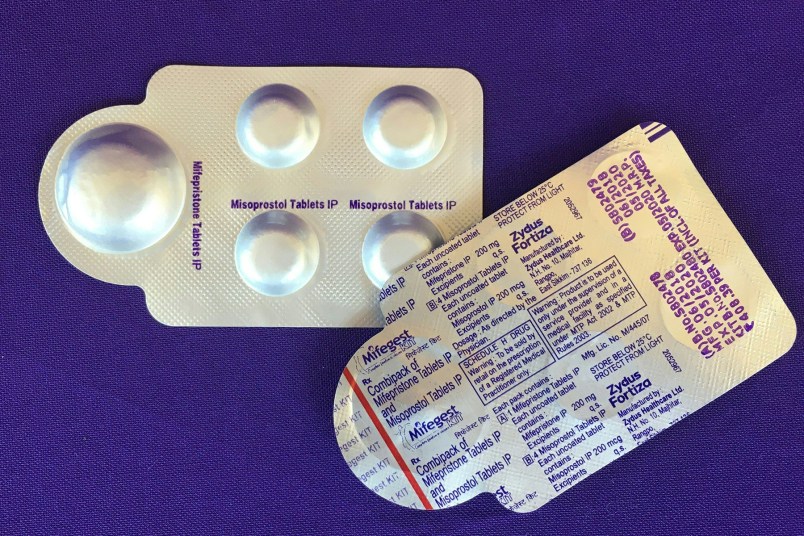It’s very likely that the Supreme Court will take up a major mifepristone case this term after the Biden administration and a manufacturer of the drug asked the justices to hear it late last week.
The case infamously originated in Judge Matthew Kacsmaryk’s Amarillo courtroom, where he ruled to revoke the Food and Drug Administration’s authorization of mifepristone wholesale. The Fifth Circuit Court of Appeals later narrowed that ruling, but would reimpose onerous and unnecessary restrictions on the drug’s accessibility that the FDA lifted in 2016 and 2021. The Supreme Court stayed those rulings.
If the Court takes it up, as expected, it’ll be the biggest abortion case since Dobbs, with nationwide implications.
“The stakes are enormous,” Sen. Ron Wyden (D-OR), a longtime champion of mifepristone, told TPM.
That’s for dual reasons. Amid the current abortion landscape, prescribing mifepristone (usually in conjunction with the much less restricted misoprostol) via telehealth and delivering it by mail — procedures that would be banned under the Fifth Circuit’s decision — have proved a lifeline for women living under anti-abortion regimes.
Medical abortions have other perks too that have long made them a preferred option — including the privacy involved in taking a couple of pills in your own home and avoiding an invasive surgical procedure that requires travel and scheduling.
“If the Supreme Court goes along with what the district court held, mifepristone would not be available throughout the country,” Sen. Mazie Hirono (D-HI) told TPM. “That would be disastrous, considering most of the abortions in our country are medication abortions.”
Hirono alludes to the other key point: The lower court rulings wouldn’t just augment the overlapping restrictions that virtually ban abortion in huge swaths of red states, particularly in the southeast.
They’d dictate mifepristone’s availability in blue states too.
“‘Sending it back to the states’ has essentially empowered anti-abortion folks who believe that they have the right to impose their will on others with whom they disagree,” Sen. Peter Welch (D-VT) told TPM.
The stakes of the case grow higher still given that so far, it has been an incredibly successful example of judge shopping for the anti-abortion doctors who brought it. The group, the Alliance for Hippocratic Medicine, incorporated in Amarillo in August 2022 (two months after Dobbs). That made it all the easier for the group to plant the case with Kacsmaryk, who gets 100 percent of the cases in his division, and is a reliable far-right activist judge. After he did their bidding, the case went to the ultra-conservative 5th Circuit — leaving the Supreme Court that overturned Roe as the last resort for abortion rights.
“They had a plan,” Wyden said. “They had a vision and it was all about turning back the clock, and they have never been reluctant to make things up. That whole business about states’ rights — baloney! They wanted a federal remedy.”
As the Biden administration has appealed to the Supreme Court for intervention, it’s put heavy emphasis on the flimsy theory of standing on which the anti-abortion doctors are bringing the case in the first place — perhaps trying to offer an off-route for the justices on a more tangential, procedural point.
“Over the nearly 23 years mifepristone has been on the market — and across the more than five million Americans who have used it to end a pregnancy — the Fifth Circuit identified only three doctors whose declarations purported to describe such a conscience injury,” the Department of Justice lawyers wrote. “Even those isolated examples do not withstand scrutiny.”
They go on to detail that the first case recounts the experience of the declarant’s partner, and that the other two claim that the doctors treated a patient for heavy bleeding and another to remove remaining tissue in the uterus.
“The declarations neither state that the declarants conscientiously objected to providing that care nor explain why, if they did object, they chose to proceed rather than invoking applicable conscience protections or allowing another doctor to step in,” the government pointed out.
Most of the injury claims rest on hypothetical situations — that a woman might have a rare adverse reaction to mifepristone, that she might go to one of the anti-abortion doctors’ hospitals instead of back to her initial provider, that for some reason no other doctor was available and they’d be forced to treat her.
The DOJ lawyers home in on another oddity in the anti-abortion doctors’ case: As they go for a home run, trying to get mifepristone yanked from the market altogether, they don’t say much of anything to elucidate why mifepristone with the pre-2016 restrictions is less harmful than mifepristone in its current form. While making the drug harder to access would likely fit the doctors’ goals, it would also raise the dosing levels again, which the FDA found to be unnecessarily high in 2016.
Since Dobbs, dozens of states have all but banned abortion, leading to a predictably gruesome stream of stories about children giving birth, doctors letting women get extremely ill before treating them, women forced to carry pregnancies that have no chance of viability.
Much of that suffering has been concentrated in red states, particularly for women who can’t afford or lack the autonomy to travel to states with abortion protections. But when the Supreme Court gets an opportunity to put mifepristone back behind various layers of restrictions, those hurdles would be imposed on blue states too.
“This is a threat to abortion access for the entire country,” Sen. Elizabeth Warren (D-MA) told TPM. “And a reminder that when the Supreme Court rolled back Roe v. Wade, it didn’t just affect people living in red states, or even purple states.”



